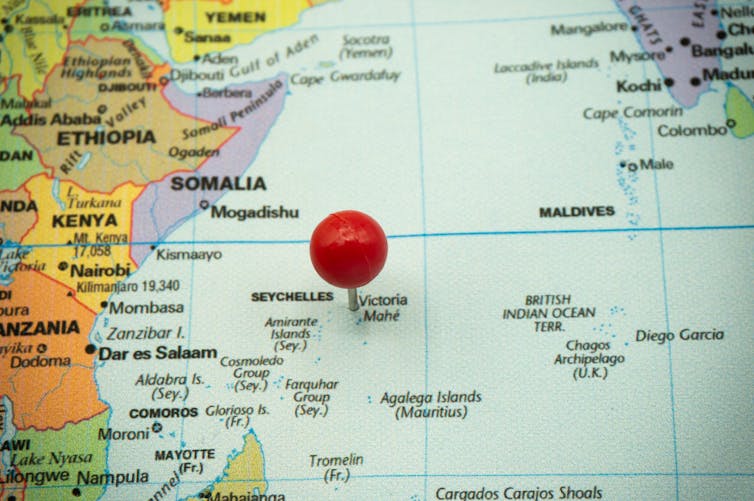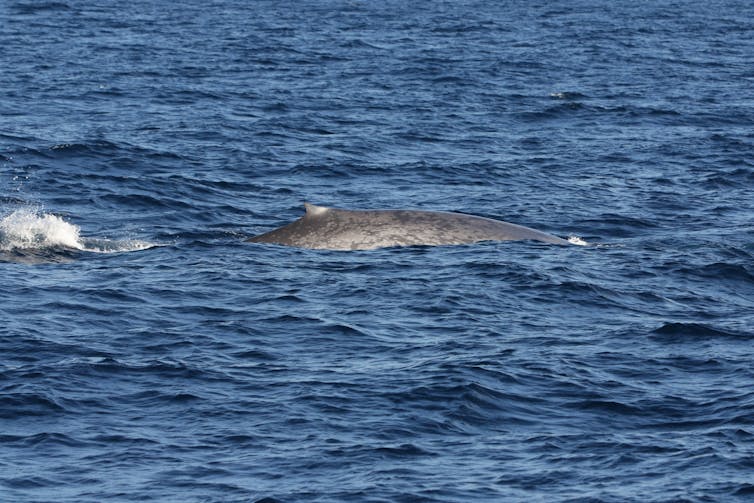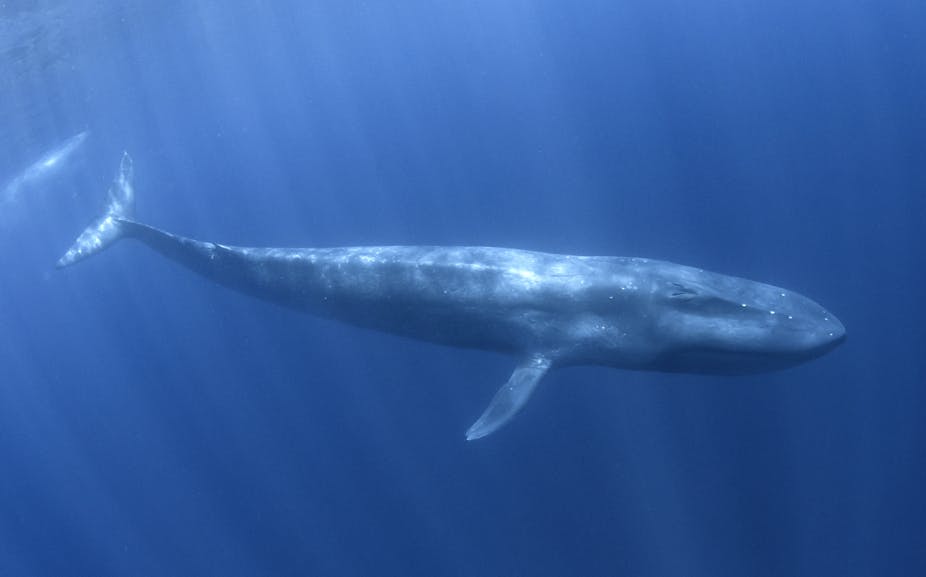Blue whales are fascinating animals. At 24-30 metres in length (longer than a basketball court) they are the largest creatures on Earth. They are also among the rarest. Estimates suggest that there are only around 5,000 to 15,000 blue whales left in the world.
Their populations experienced a 89-97% decline due to commercial whaling activities worldwide that started in the North Atlantic in 1868. Blue whales were primarily valued for their blubber, transformed into oil and used in cosmetics and soap, for the lubrication of industrial equipment, and as lamp oil. In 1978, the last deliberate capture of a blue whale was recorded off Spain.
Today, blue whales are found in all oceans except the Arctic. They usually migrate from their summer feeding grounds where they almost exclusively feed on krill to their winter breeding grounds. However, their migration patterns are still poorly understood, particularly in the Indian Ocean, where limited research has been conducted.
Historically, the Seychelles archipelago – off the coast of east Africa – was an opportunistic whaling ground for Soviet whaling fleets en route to and from the Antarctic. In the waters of the northern Indian Ocean, whalers illegally killed more than 1,200 blue whales, including 500 near the Seychelles, between 1963 and 1966.

Since then, no dedicated research had occurred to assess the abundance of blue whales in this region until 2020, when I partnered with the University of Seychelles, Oceanic Films (UK) and my colleague, Kate Stafford, to investigate.
We carried out two expeditions in November 2020 and 2021. After surveying about 5,500km across the northern Seychelles, we had a total of five sightings of up to 10 blue whales.
This was a phenomenal finding. We were prepared to not see any blue whales due to the high level of hunting that occurred fairly recently and absolutely no information was available since the last blue whale was killed in the region in 1964.
When blue whales were sighted, we approached them slowly to obtain details of their group size and behaviour. Photographs of both left and right sides of the dorsal region were taken to identify them.
Because colouration patterns are unique to each animal, we knew that at least five individuals were identified during this expedition.
After sharing our pictures with other research groups working on blue whales in the Indian Ocean, no “match” was found. This means the whales we identified in Seychelles might have been photographed for the first time ever!
Even though blue whales are no longer hunted and are protected by several international conventions, they are still listed as endangered on the IUCN (International Union for the Conservation of Nature) Red List of Threatened Species. They face a range of threats. For instance, shipping traffic causes noise pollution that can alter communication and lead to collisions. Climate change is also affecting the distribution and abundance of their key food, krill.
Finding the whales
The blue whale’s vast oceanic habitat and elusive nature make them incredibly challenging to study. Moreover, their deep dives and extensive migrations spanning thousands of kilometres present logistical hurdles for researchers aiming to track their movements and behaviour.
Understanding their ecology, population dynamics and conservation therefore requires innovative and resource-intensive research methods, such as systematic surveys from large vessels or planes to assess their abundance or satellite tagging to investigate their movements and migrations.
Our expeditions consisted of vessel-based visual surveys that focused on the deep waters (500−2,000 metres) off the northern portion of the Mahé Plateau.
In addition, for over a year, we placed a hydrophone (an underwater microphone capable of recording whale vocalisations) in an area where blue whales were likely to occur. This allowed us to confirm that blue whales in Seychelles were more common than we thought but highly seasonal (even though we recorded blue whale calls throughout the year), primarily from December to April.
This method also revealed that our expeditions (in November of 2020 and 2021) did not occur when blue whales were the most abundant. It means that our future surveys will have to take place during the months of March and April, when their abundance is at its peak.
Their songs matched those of blue whales recorded near Sri Lanka (about 3,100km from Seychelles), in the central tropical Indian Ocean. The seasonality in Seychelles is similar to the presence of blue whales in Sri Lanka, which is also highest from December to April.

After spending five weeks scanning the ocean, we recorded a total of 23 species of whales and dolphins in 30 days of active search effort, which is remarkable.
We recorded over 100 sightings of Bryde’s whales (Balaenoptera edeni), a non-migrating whale species exclusively living in tropical and subtropical waters, but also many sperm whales (Physeter macrocephalus) and beaked whales. The presence of all these species in Seychelles suggests that the environment is productive enough to support large quantities of cetaceans. We will further investigate this in the future, particularly to ensure that these extraordinary animals, including blue whales, persist in these waters.
Of the four subspecies of blue whale that we know exist, three are known to be present in the Indian Ocean. We believe that the pygmy blue whale is the subspecies visiting Seychelles, based on the physical characteristics of the animals we observed and, most importantly, the nature of their call.
The pygmy blue whale is generally smaller than other subspecies. It typically reaches lengths of around 21-24 metres. Other blue whale subspecies, such as the Antarctic blue whale, can grow to 30 metres or more. The pygmy blue whale is primarily found in the southern hemisphere and has acoustic characteristics that are distinct from others, particularly Antarctic blue whales.
What’s next?
Because of our blue whale discoveries, we have engaged with local tourism operators and the government, particularly to identify measures to limit the impact of the potential development of whale watching as an activity. These are positive steps towards their conservation. The involvement of local students at the University of Seychelles and young researchers is also critical for the long-term sustainability of research and conservation initiatives.
We still know so little about blue whales. But the data collected in Seychelles gives us hope and encourages us to do more.
We now need to increase our research efforts to assess the abundance of these blue whales in Seychelles and discover why they are using Seychelles’ waters. Do they just breed or feed in these waters, or both?
We also want to gain further insights into what they eat and how the changing climate is affecting their distribution and behaviour in the tropical waters of the Indian Ocean.

